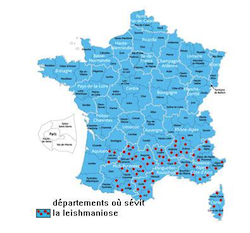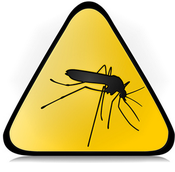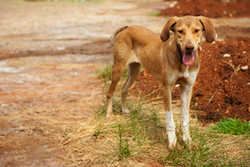Leishmaniasis
 The leishmaniasis is a disease related to the presence, within the body of an animal, small parasites: the Leishmania. These are transmitted to an animal by the Sting a very close Diptera insect of the mosquito.
The leishmaniasis is a disease related to the presence, within the body of an animal, small parasites: the Leishmania. These are transmitted to an animal by the Sting a very close Diptera insect of the mosquito.
The disease is common in the dog while the cat seems very unresponsive.
Human, just as the dog, may be contaminated.
In which geographical areas leishmaniasis she rages ?
Leishmaniasis is present throughout the Mediterranean basin (in Europe: Spain, France, Greece, Italy, Portugal…)
In France, It is found mainly in the regions: Provence-Alpes-Côte d'Azur, Corsica, Languedoc-Roussillon, Midi-Pyrenees.
It extends to the south west and back to southern Rhône-Alpes region.
Mode of disease transmission
The transmission of the disease is, most often, related to the bite of a called Diptera sandfly : a female sand fly bites a dog carrier and absorbs Leishmania parasites in a blood meal. They multiply in the gut of the insect, when a new Sting, will infect another animal through saliva. The sand fly is particularly present May to October and its activity is highest at dusk.
The disease can also be transmitted from a pregnant female its small or during blood transfusion.
Direct transmission from dogs to humans is not proven : the man is contaminated by the bite of the sandfly present in their environment.
clinical picture in dogs
In a number of dogs, parasite development is limited and results in no clinical signs.
Among the sensitive individuals, Leishmania will gradually contaminate marrow cells, liver, The rates, ganglia, of the digestive mucosa or the skin of the affected animal causing various symptoms :
In the classical forms, animals have:
– A reduction and a marked tiredness, First after exercise, then permanently
– A progressive weight loss and significant muscle wasting (young animal with an old dog appearance)
– Anemia and coagulation disorders
– Various skin disorders with possible ulceration of the nose and ears, hair loss (depilation of the free edge of the ears or around the eyes), significant thickening of the pads, elongation claws…
– Eye disorders
– Urinary problems, the parasite can generate renal abnormalities causing severe renal insufficiency.
– A generalized reaction with the size of increase rate of the animal and all nodes.
The clinical picture is highly polymorphic and some dogs may present only one of these symptoms, or simple tiredness.
Furthermore, of atypical leishmaniasis are described:
– Digestive forms,
– Nerve forms (epileptiform seizures)
– Bone and joint damage,
– Widespread forms lightning, especially in puppies
– A skin disease with onset in animals nodules or pustules
Finally, dogs first "resistant" the disease will be able to express various symptoms of leishmaniasis following a decreased their immune : especially during another concomitant disease or general fatigue (as after parturition e.g.)
Clinical picture in humans
As in dogs, a large number of humans are carriers disease without in present symptoms.
In France, various cases of leishmaniasis observed are associated with the parasite Leishmania infantum.
Several forms of the disease are encountered:
– The visceral form of the child : young children with (usually under 5 years) have fever episodes, a marked pallor and increased spleen.
– The Native localized cutaneous leishmaniasis (rare): infected individuals have small skin lesions crusted and painless located, in general ,on the face and forearms. These lesions heal spontaneously.
– The Mediterranean visceral leishmaniasis in adults encountered most often in immunocompromised patients (those with hematologic malignancies, congenital immunodeficiency, having taken a long treatment with corticosteroids or receiving immunosuppressive therapy for organ transplantation…)
Diagnosis of the disease in dogs and prognosis
Leishmaniasis should be suspected in an animal with one or more of the symptoms described above, living or who stayed in Mediterranean. THEincubation the disease can be very long (several months, even years), he even be thinking about it for dogs no longer living in the regions long.
Most often, one blood sample performed by your veterinarian will diagnose the disease (either directly to the clinic, or by various analysis methods available in the laboratory: IFI, ELISA, PCR).
Sometimes the highlight of the disease require ofother types d’exams such as skin layers or biopsies, punctures or biopsies reaction nodes or spleen, bone marrow aspiration, liquid puncture synovial…
The prognosis depends largely on the stage of the disease is detected. He will be extremely reserved in dogs where leishmaniasis is diagnosed when kidney function is compromised or when severe anemia is present.
Treatment
For animals susceptible to the parasite, the disease will evolve, eNo untreated specific, to a fatal kidney failure.
Traditional treatment of leishmaniasis is a treatment based ofAntimoniate de méglumine (Glucantime) administered daily by injection during 1 month, associated with theallopurinol (Zyloric) by oral administered for months to reduce the risk of relapse.
These molecules can aggravate already existing kidney damage, This explains the very poor prognosis animals in which leishmaniasis has caused kidney damage.
Miltefosine is a molecule also used but not, at present, Available in France
One clinical monitoring the animal must be leishmanian (Monitoring of renal function, the absence of anemia, the evolution of symptoms after implementation of treatment…) and blood tests Successive will verify thedisease progression.
Prevention of leishmaniasis
Leishmaniasis is a serious illness, life-threatening animal, whose diagnosis is not always easy and whose treatment is cumbersome and expensive. It occurs in more than twenty French departments.
It comes, Furthermore, a disease transmissible to humans. The dog, although it is not necessarily directly responsible for human contamination, An important reservoir of the parasite (including dogs carrying the parasite but not expressing disease)
Protecting your pet against this parasite is crucial for both the dog itself as to avoid the spread of disease.
Prevention against bites
 to ensure the best prevention against sandfly bites, it suits:
to ensure the best prevention against sandfly bites, it suits:
– Eliminate all sources ofbackwater near homes
– Returning the animals at night
– Reduce the risk of bites by applying pest Control products active against sandflies ( spray insecticide, collar impregnated with deltamethrin or permethrin pipette to be applied to the animal all 3 weeks)
This treatment should be continued so long as the hot weather (almost to October in warmer areas endemic for leishmaniasis)
Attention, tll pesticides are not active against sandflies and those that are are to book the dog (toxic in cats). Do not hesitate to seek advice from your veterinarian.
Vaccination
One vaccine against leishmaniasis canine is now available.
It is highly recommended for all dogs living in the departments where there is leishmaniasis, and for all those who spend their holidays.
It can be given from the age of 6 month in any dog uncontaminated (a blood test will verify that the animal is not already carrying the disease)
The first year, three primary immunization injections must be performed (the second and third injections are given respectively three weeks and six weeks after the first vaccination)
The reminders then perform every year.
The vaccine injection can not be performed along with the usual vaccinations your dog (Prevention against distemper, Hepatitis Rubarth, leptospirosis, parvovirose, rage). A period of one month minimum will be maintained between these vaccinations and the vaccine against leishmaniasis.
§
Leishmaniasis is a severe disease or death, transmitted by an insect cousin mosquito, against which it is essential to protect your dog if you live in the contaminated area or if you plan to vacation there.
This article is protected by copyright © Vetup

